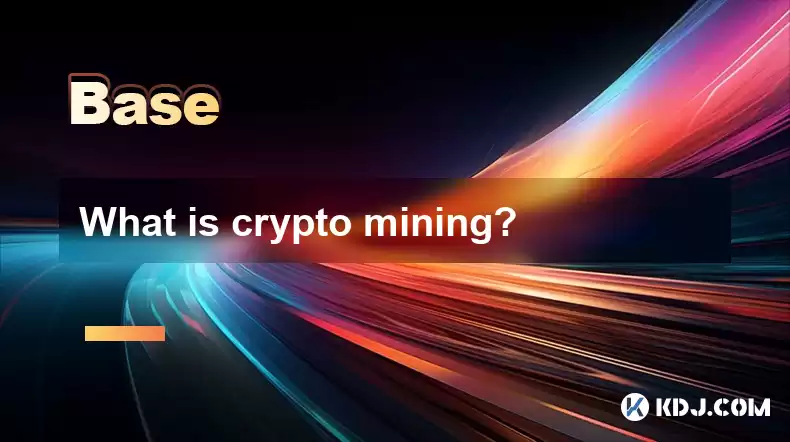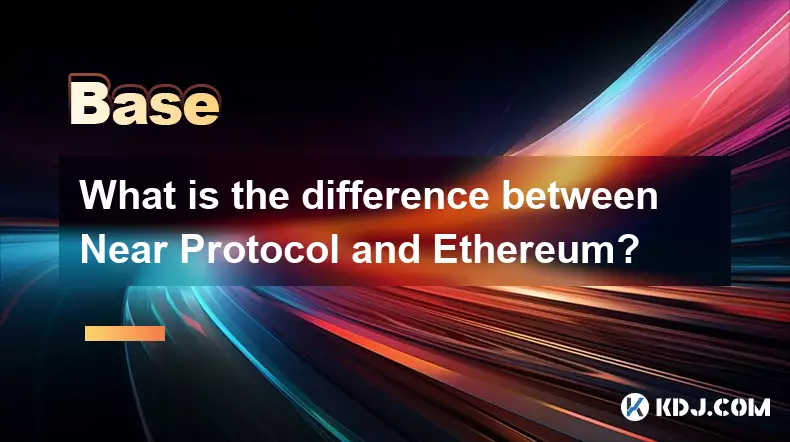-
 bitcoin
bitcoin $108183.343957 USD
1.12% -
 ethereum
ethereum $3953.318181 USD
2.13% -
 tether
tether $1.000758 USD
0.05% -
 bnb
bnb $1102.411872 USD
1.73% -
 xrp
xrp $2.377410 USD
1.30% -
 solana
solana $185.715867 USD
0.05% -
 usd-coin
usd-coin $1.000561 USD
0.08% -
 tron
tron $0.320859 USD
2.39% -
 dogecoin
dogecoin $0.194561 USD
3.07% -
 cardano
cardano $0.647327 USD
2.68% -
 hyperliquid
hyperliquid $37.310392 USD
1.96% -
 ethena-usde
ethena-usde $0.999792 USD
0.04% -
 chainlink
chainlink $17.181017 USD
2.56% -
 stellar
stellar $0.316938 USD
1.13% -
 bitcoin-cash
bitcoin-cash $472.186880 USD
1.35%
What is crypto mining?
Crypto mining verifies blockchain transactions using powerful computers to solve complex problems, rewarding miners with cryptocurrency. Profitability depends on factors like hardware, electricity costs, and cryptocurrency value, raising environmental concerns due to high energy consumption.
Mar 04, 2025 at 11:07 pm

- Crypto mining is the process of verifying and adding transaction blocks to a blockchain.
- Miners use powerful computers to solve complex mathematical problems.
- Successful miners are rewarded with cryptocurrency.
- Different cryptocurrencies have different mining methods and requirements.
- Mining profitability depends on several factors including hardware costs, electricity prices, and cryptocurrency value.
- Environmental concerns are increasingly associated with the energy consumption of mining.
Crypto mining is the backbone of many cryptocurrencies, acting as the security mechanism and the method for creating new coins. It involves using powerful computing resources to solve complex cryptographic puzzles. These puzzles verify transactions and add them to a public, distributed ledger known as a blockchain. Think of it as a digital gold rush, where miners compete to solve these puzzles first to earn rewards.
How Does Crypto Mining Work?The process starts with a transaction broadcast across the network. Miners collect these transactions and group them into a "block." They then use specialized hardware to solve a computationally intensive problem, a cryptographic hash function. The first miner to find the solution adds the block to the blockchain, and the network confirms the validity of the transactions within. This process ensures the integrity and security of the blockchain.
Different Types of Crypto Mining:Not all cryptocurrencies are mined in the same way. The most common methods include:
- Proof-of-Work (PoW): This is the original and most well-known method. Miners compete to solve complex mathematical problems using specialized hardware like ASICs (Application-Specific Integrated Circuits). Bitcoin uses PoW.
- Proof-of-Stake (PoS): This method requires miners (often called validators) to "stake" a certain amount of cryptocurrency to participate. Validators are chosen randomly based on the amount staked, and they are rewarded for validating transactions. This method is generally considered more energy-efficient than PoW.
- Delegated Proof-of-Stake (DPoS): In DPoS, token holders vote for delegates who validate transactions and earn rewards. This is designed to be more efficient and scalable than traditional PoS.
The hardware needed varies greatly depending on the cryptocurrency and mining algorithm. For PoW cryptocurrencies like Bitcoin, specialized ASICs are typically required. These are highly efficient chips designed specifically for solving the cryptographic puzzles. For PoS cryptocurrencies, powerful computers might still be beneficial, but the requirements are generally less demanding. GPUs (Graphics Processing Units) can also be used for mining some cryptocurrencies, particularly those with algorithms that are less specialized.
Software and Setup:Before starting to mine, you need appropriate mining software. This software connects your hardware to the cryptocurrency network, allowing you to participate in the mining process. Different software exists for different cryptocurrencies and algorithms. You'll need to choose the right software compatible with your hardware and the coin you wish to mine. The setup process usually involves configuring the software, connecting to a mining pool (optional but recommended), and setting up your wallet to receive your mining rewards.
Mining Pools:Mining pools are groups of miners who combine their computing power to increase their chances of successfully mining a block. When a block is mined, the reward is shared amongst the pool members based on their contribution. Joining a mining pool significantly increases your chances of earning rewards, especially if you have limited computing power.
Profitability of Crypto Mining:The profitability of crypto mining is dynamic and depends on several factors:
- The price of the cryptocurrency: Higher cryptocurrency prices mean higher rewards.
- The difficulty of mining: As more miners join the network, the difficulty increases, making it harder to mine blocks.
- Electricity costs: Mining consumes significant amounts of electricity. High electricity prices can significantly reduce profitability.
- Hardware costs: The initial investment in mining hardware can be substantial.
- Mining pool fees: Mining pools often charge fees for their services.
The energy consumption of crypto mining, particularly PoW, has raised significant environmental concerns. The large amounts of electricity required by mining operations contribute to carbon emissions. This has led to discussions about the sustainability of crypto mining and the exploration of more energy-efficient consensus mechanisms like PoS.
Frequently Asked Questions:Q: Is crypto mining profitable?A: The profitability of crypto mining is highly variable and depends on many factors, including the cryptocurrency's price, the difficulty of mining, electricity costs, and the cost of hardware. It's not always guaranteed to be profitable.
Q: What are the risks involved in crypto mining?A: Risks include the initial investment cost of hardware, fluctuating cryptocurrency prices, increasing mining difficulty, and high electricity costs. The return on investment is not guaranteed.
Q: Is crypto mining legal?A: The legality of crypto mining varies by jurisdiction. While mining itself isn't inherently illegal, regulations may apply concerning taxation and environmental impacts.
Q: How much electricity does crypto mining consume?A: The electricity consumption of crypto mining varies greatly depending on the cryptocurrency, the mining hardware, and the efficiency of the operation. It can be substantial, especially for PoW cryptocurrencies.
Q: Can I mine cryptocurrency on my home computer?A: You can, but it's unlikely to be profitable for most cryptocurrencies, especially those using PoW. The computing power of home computers is often insufficient to compete with large-scale mining operations. You might be able to mine less popular altcoins, but even then profitability is questionable.
Disclaimer:info@kdj.com
The information provided is not trading advice. kdj.com does not assume any responsibility for any investments made based on the information provided in this article. Cryptocurrencies are highly volatile and it is highly recommended that you invest with caution after thorough research!
If you believe that the content used on this website infringes your copyright, please contact us immediately (info@kdj.com) and we will delete it promptly.
- Floki, Elon Musk, and the Meme Spark: What's Next?
- 2025-10-20 20:45:12
- Jupiter's Ultra V3: Revolutionizing Solana Trading with a Next-Gen Engine
- 2025-10-20 20:45:12
- Dogecoin, Shiba Inu, and Ozak AI: Navigating the Meme Coin Evolution in 2025
- 2025-10-20 21:05:16
- Irish Drivers, Storm Bram, and the Humble €1 Coin: Winter Car Care Tips
- 2025-10-20 20:30:12
- Decoding the Crypto Comeback: How Bitcoin, Altcoins, and Macro Trends Shape Your Portfolio in '25
- 2025-10-20 21:05:16
- SUI Crypto, Developer Surge, and Shiba Inu: Navigating the Volatile Crypto Seas
- 2025-10-20 21:10:01
Related knowledge

How do decentralized identity (DID) solutions work?
Oct 14,2025 at 11:36pm
Understanding Decentralized Identity in the Blockchain Ecosystem1. Decentralized identity (DID) solutions are built on blockchain networks, allowing i...

What is the difference between Near Protocol and Ethereum?
Oct 15,2025 at 08:01am
Near Protocol and Ethereum: Core Architectural Differences1. Near Protocol operates on a sharded blockchain architecture known as Nightshade, which al...

What does it mean for code to be "open source" in crypto?
Oct 12,2025 at 01:54pm
Understanding Open Source in the Cryptocurrency Ecosystem1. In the context of cryptocurrency, open source refers to software whose code is publicly ac...

What is the purpose of a "testnet"?
Oct 12,2025 at 09:01am
Understanding the Role of Testnets in Blockchain Development1. A testnet serves as a parallel version of a blockchain network, designed specifically f...

How to avoid phishing scams in crypto?
Oct 13,2025 at 06:18pm
Understanding Common Crypto Phishing Tactics1. Cybercriminals frequently use fake websites that mirror legitimate crypto exchanges or wallet platforms...

What is the difference between single-collateral and multi-collateral Dai?
Oct 12,2025 at 05:18pm
Understanding Single-Collateral Dai1. Single-Collateral Dai (SCD) was the original version of the Dai stablecoin launched by MakerDAO in 2017. It allo...

How do decentralized identity (DID) solutions work?
Oct 14,2025 at 11:36pm
Understanding Decentralized Identity in the Blockchain Ecosystem1. Decentralized identity (DID) solutions are built on blockchain networks, allowing i...

What is the difference between Near Protocol and Ethereum?
Oct 15,2025 at 08:01am
Near Protocol and Ethereum: Core Architectural Differences1. Near Protocol operates on a sharded blockchain architecture known as Nightshade, which al...

What does it mean for code to be "open source" in crypto?
Oct 12,2025 at 01:54pm
Understanding Open Source in the Cryptocurrency Ecosystem1. In the context of cryptocurrency, open source refers to software whose code is publicly ac...

What is the purpose of a "testnet"?
Oct 12,2025 at 09:01am
Understanding the Role of Testnets in Blockchain Development1. A testnet serves as a parallel version of a blockchain network, designed specifically f...

How to avoid phishing scams in crypto?
Oct 13,2025 at 06:18pm
Understanding Common Crypto Phishing Tactics1. Cybercriminals frequently use fake websites that mirror legitimate crypto exchanges or wallet platforms...

What is the difference between single-collateral and multi-collateral Dai?
Oct 12,2025 at 05:18pm
Understanding Single-Collateral Dai1. Single-Collateral Dai (SCD) was the original version of the Dai stablecoin launched by MakerDAO in 2017. It allo...
See all articles










































































